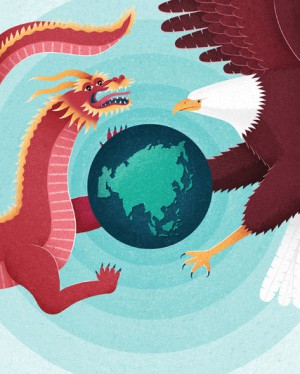President Obama came to Malaysia recently for the latest U.S.-Asean and East Asia Summits, reaffirming America’s strategic commitment to Asia. But most of the 10 Asean countries responded as they often have in recent years: They hedged.
From Our Advertisers
They stopped short of fully aligning with Washington. And even some of the governments increasingly worried about China’s creeping assertiveness in the South China Sea, like Malaysia, Singapore and Indonesia, have preferred to selectively accommodate Beijing rather than confronting it head-on.
This balancing act has meant keeping some distance from Washington, and at times defying its will. Even so, the United States government should welcome this behavior: Hedging by small and mid-level states in Southeast Asia is good for stability in the region, and that’s good for America.
 Take Malaysia, which played host to the 27th Asean summit last month. Partly in response to China’s increasing encroachment in its waters since 2013, Prime Minister Najib Razak has steadily upgraded the partnership between Malaysia and Obama’s America, by joining the Trans-Pacific Partnership, collaborating to counter the so-called Islamic State and allowing the U.S. Navy to fly its spy planes from Malaysian airstrips and dock its vessels at Malaysian ports.
Take Malaysia, which played host to the 27th Asean summit last month. Partly in response to China’s increasing encroachment in its waters since 2013, Prime Minister Najib Razak has steadily upgraded the partnership between Malaysia and Obama’s America, by joining the Trans-Pacific Partnership, collaborating to counter the so-called Islamic State and allowing the U.S. Navy to fly its spy planes from Malaysian airstrips and dock its vessels at Malaysian ports.
At the same time, however, the Najib government has denied that any expanded defense activities with the United States were aimed at Beijing. In fact, it has also been developing closer military ties with China. During a visit by Chinese President Xi Jinping in October 2013, the two countries upgraded relations to a “comprehensive strategic partnership.”
In September, they conducted their first bilateral live-troop exercises in the Strait of Malacca, the largest-ever military drill between China and an Asean country. Last month, Malaysia allowed Chinese ships to stop in Kota Kinabalu, near the South China Sea — at the same port the U.S.S. Lassen used a month earlier while carrying out a freedom-of-navigation operation near the artificial islands China has been building in the area.
Malaysia’s tightened military relation with China complements already robust economic ties. Malaysia is China’s largest trading partner in the Asean region, and China is Malaysia’s largest trading partner in the world. Last month, 1Malaysia Development Berhad, a debt-ridden sovereign wealth fund, announced a $2.3 billion deal to sell its power assets to a Chinese state-owned company.
But the Malaysian government is not falling entirely into Beijing’s embrace either. While continuing to leverage its longstanding ties with the United States, it is also using Asean-based forums and other multilateral institutions to mitigate the risks of China’s rise.
Malaysia hardly is alone in hedging. Most Asean countries (not the Philippines) and traditional American allies in the Asia-Pacific region, such as South Korea and Australia, have displayed some degree of deference toward China on certain issues while pushing back against it on others.
Many have promoted closer commercial relations with Beijing, joining the Asian Infrastructure Investment Bank it spearheaded, and collaborating on trade, investment and major infrastructure projects. Some have expressed support for China’s “One Belt, One Road” initiative and participated in the Xiangshan Forum, a security dialogue hosted by Beijing. And some — South Korea, Vietnam, Myanmar, Cambodia, Laos, Thailand — even sent representatives to the military parade in Beijing in September celebrating the 70th anniversary of the end of World War II, despite the pointed absence of high-level officials from America and its key allies.
But smaller and mid-level states in Asia have also tried to reduce the risks of becoming dependent on China. Some, like Indonesia, have rejected or distanced themselves from several of Beijing’s initiatives, such as its proposal to conduct joint military drills with Asean countries in the South China Sea. Others, like Vietnam, have responded cautiously to China’s proposed maritime Silk Road.
States in the region have internationalized the South China Sea issue by bringing it to Asean-led multilateral forums. They have insisted on the need to conclude a code of conduct in those waters. They are developing military ties with as many powers as possible.
This is logical behavior. Hedging is less about countering either the United States or China per se than managing the systemic risks of dealing with any great or rising power. And it is all the more rational in Southeast Asia today because of concerns about the long-term sustainability of America’s commitment to the region, wariness over an ascendant China’s future intentions and uncertainty about the direction of U.S.-China relations.
Although the hedging of small and middle powers means keeping the greater powers at arm’s length, China and the United States should embrace and encourage the approach. This is partly because it helps maintain stability in the region by preventing the polarization of power. It also ensures Asean’s neutrality, and so its centrality, as an inclusive platform for discussing and managing the security and prosperity of the region. Compelling or inducing regional powers to take sides would only risk triggering vicious cycles of actions and counteractions, heightening tensions between the two major powers.
Washington may not quite be getting its way with states like Malaysia, but that’s for the better — for Malaysia and the region, as well as China and the United States itself.
Cheng-Chwee Kuik is an associate professor at National University of Malaysia.

